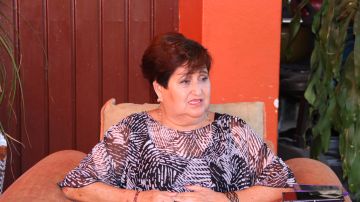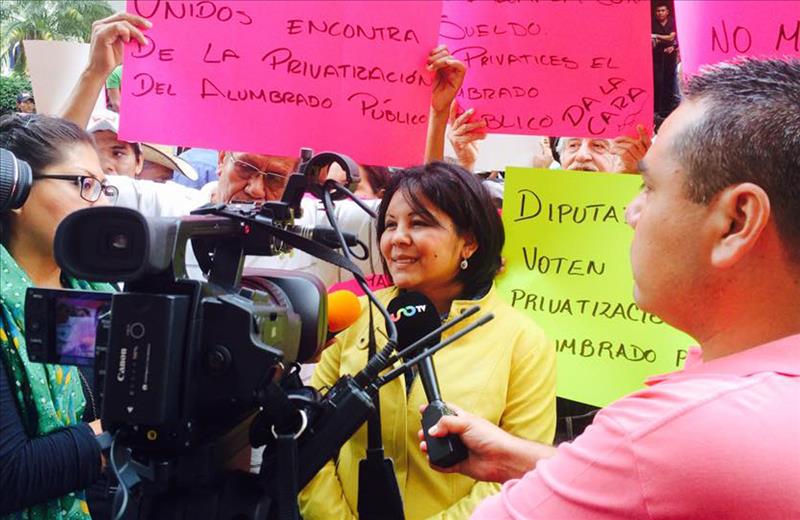Irma Camacho, Temixco’s New Mayor
Dead people here and there, bodies hanging from bridges, kidnappings, extortions: it was clear that in Temixco things were not running their usual course, but this woman never believed she would soon be taking the place of a murdered official

Irma Camacho, alcaldesa de Temixco. Crédito: Gardenia Mendoza | Impremedia
Mexico.- A few days ago, while the clock marked its first minutes of 2016, two bodyguards were ready to fire their long AK47’s at any threat that could come from the long wall that separates the street from a two-story orange and yellow house with a leafy mandarin tree in the front yard.
Gisela Mota had not been murdered yet, hours after becoming mayor of Temixco (January 2), and Irma Camacho, 65, owner of the colorful house, retired elementary teacher, mother of four, grandmother of six grandchildren and two great-granddaughters, did not imagine that she would replace the 33-year-old woman, the same who months earlier had invited her to be her representative.

“We never saw any risk: we used to campaign alone, Gisela and I, walking down the streets, knocking door to door,” recalls Camacho sitting in a chair that is part of the room located in the courtyard, where eight piñatas are hanging. “I do not know why they would kill her,” she says. “I found out because someone called me, it made me get really angry, why would they murder a working woman! I demand justice for her and those who have died as well.”
Dead people here and there, bodies hanging from bridges, kidnappings, extortions: it was clear that in Temixco things were not running their usual course. But no one believed they would be attacked by the Guerreros Unidos and Los Rojos —two cells derived from the Beltran Leyva cartel-, although other scoundrels had attacked about 100 council members throughout the country in recent years.
Graco Ramirez, the Governor of Morelos, where the municipality of 100,000 inhabitants is located, suggested that the crime is related to the support that Mota gave to the Unified Command, which is comprised by federal and state police to replace the municipal security, alleged accomplice in the crime.
– Will you accept the Unified Command? – We ask teacher Camacho. Many mayors are opposed on the grounds that it may become a political weapon under the governor’s command and, anyway, crime can corrupt anyone.
– I don’t know yet. That decision will be taken in council, as a team, when they take office.
A Believer, Guarded
It’s 11 a.m. and a tasty aroma beckons from the kitchen. We can deduce it by the smell of fried onions and because Marita Hiromoto (Camacho’s daugther; Suyuco’s mother, the darling granddaughter and her press liaison) is in front of the stove and shouts to someone from afar, “Tell the cop to look for epazote.”
The cop is one of the guards with rifles who now takes watches over the teacher after an armed group went to her predecessor’s bedroom shouting, ‘Who is Gisela Mota?’, and murdered her in the living room, in front of her parents; a case that is still unclear.
– I did not want that security guard, it was imposed- she says. See, I am not afraid, I have clean hands.
Irma Camacho “has her own mechanisms of protection”, she says, talking about herself in third person.
“As Irma Camacho is a true believer, she makes the sign of the cross over herself every morning and walks to a small altar, in honor of the Virgin of Guadalupe, and commends herself to her.”
And beyond her Catholic faith, she also relies on the network of social protection. It is a network of people whom she taught for 30 years, thousands of alumni who are now entrepreneurs, farmers and even an occasional famous person, such as the former director of the Institute of Security and Social Services, Juan Manuel Delago.
Still, she agrees that she must go everywhere with a security team.
A Family Woman
The gate makes a creaking noise and a man with Asian features, dressed in olive green, makes his way softly into the home, while Irma Camacho speaks of her father-in-law, a doctor from Osaka (Japan), who came to the United States during World War II but due to his background was not accepted. He then came to Mexico on a boat where he was left for dead and thrown into the Sea of Cortez.
“Dolphins rescued him…” said the teacher before being interrupted. “Oh, I want you to meet my husband.”
Manuel Hiromoto and the Mayor of Temixco have been married for 45 years, they still call each other “my love” and have three meals together. They met as teenagers, shortly after both of their families settled in that town of Morelos.
Her family came from Piripitio, Michoacan, in search of a better economy; his is more complex.
After “dolphins” took Hiromoto’s father out of the water, he joined a Mexican military regiment as a doctor until the government of Mexico recruited him at Hacienda Temixco with other citizens from Germany, Italy and Japan.
“They thought they were spies (from the Triple Entente),” says Manuel.
When they finally released him, without evidence, grandfather Miramoto stayed in Mexico, got married, had children and taught them to value the family.
– Do you support your wife as mayor?
– I am worried about the responsibility that she will face, but everything will be okay.
That’s all that Manuel says, who requests that no more pictures of recordings be taken of the meeting.
He leaves his wife with Marita, who comes to Camacho’s side after giving instructions to two other women that help with the chores.
– What would you do if the criminals ask you to give them 10% out of public works to launder money or if they want to tell you what to do? – We ask the mayor.
– When I feel threatened, I will turn to the federal or state government.
Irma Camacho gets out of the chair. Someone brings a jar filled with water, oats and chocolate:
“It’s for my spider monkey; they gave it to me when he was a tiny baby, 21 years ago. He is part of the family … when he was five years old he fought with my son in the yard for a tricycle, like two children.
“Come with me, I’ll show you,” she says.
On her way, she stops in front of a fountain surrounded by flowers and bonsais. She lifts a pot:
“Look, they are all four-leaf clovers: they bring good luck. I am very lucky.”




